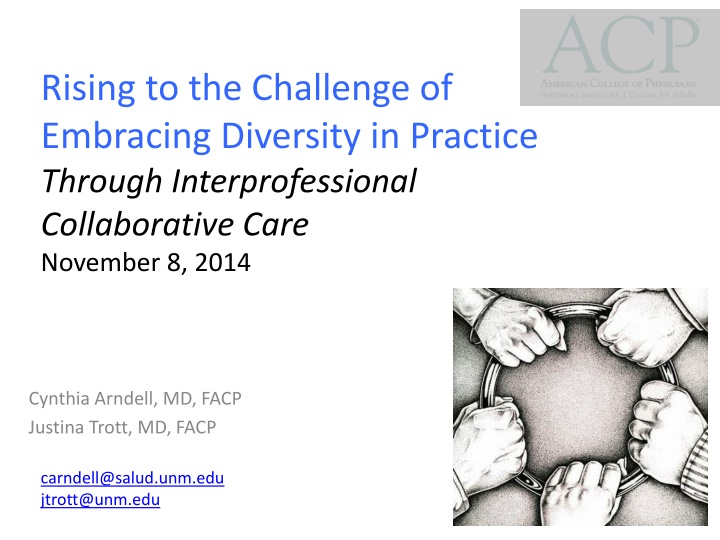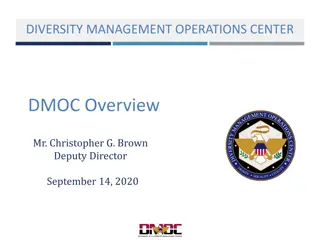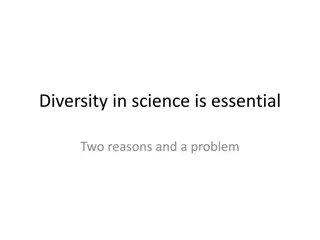
Embracing Diversity in Interprofessional Collaborative Care
Explore the essence of interprofessional collaborative practice, its impact on healthcare delivery, and ways to enhance teamwork for patient-centered care through insights shared at a healthcare seminar. Delve into the benefits, challenges, and evidence supporting interprofessional collaboration in healthcare settings.
Download Presentation

Please find below an Image/Link to download the presentation.
The content on the website is provided AS IS for your information and personal use only. It may not be sold, licensed, or shared on other websites without obtaining consent from the author. If you encounter any issues during the download, it is possible that the publisher has removed the file from their server.
You are allowed to download the files provided on this website for personal or commercial use, subject to the condition that they are used lawfully. All files are the property of their respective owners.
The content on the website is provided AS IS for your information and personal use only. It may not be sold, licensed, or shared on other websites without obtaining consent from the author.
E N D
Presentation Transcript
Rising to the Challenge of Embracing Diversity in Practice Through Interprofessional Collaborative Care November 8, 2014 Cynthia Arndell, MD, FACP Justina Trott, MD, FACP carndell@salud.unm.edu jtrott@unm.edu
Objectives: Define interprofessional collaborative practice (IPC) Discuss the attributes of an effective team Describe ways to improve IPC in your current practice setting
Introductions Your name/title What setting do you practice in currently? Think, pair, share: (turn to your neighbor and discuss the questions below): Who are the members of your healthcare team? How well does your team work together in delivering patient-centered care?
What does interprofessional collaborative practice mean to you?
Interprofessional Collaborative Practice Multiple health workers from different backgrounds work together with patients, families, caregivers and communities to deliver the highest quality of care World Health Organization, 2010
What is the evidence? Editorial: Bridging the Quality Chasm: Interprofessional Teams to the Rescue? Weinstein, R.S. et al, Corrected Proof. Published online, February 11, 2013 Improved Patient Outcomes, Zwarenstein et al, JIC Supplement 1:2005 Improved Cost Efficiency, D Amour et al 2005 & Rogowski et al 2001 Improved Health Professional Satisfaction, Cohen & Bailey 1997 Improved Work Places, Shamian & El-Jardali 2007
A team of experts does not make an expert team Salas et al. Toward understanding of team performance and training. In Swezey, Salas, eds. Teams: Their training and performance. Norwood, NJ Ablex, 1992:3-29.
Teamwork at Its Best Recall the best healthcare team you were ever part of
Consider the following What were the circumstances? Who were the team members, i.e., nurse, social worker, MD, patient case manager? What were the patient outcomes, i.e., why was it a success story? What were the characteristics/qualities of the team members that made it an effective, collaborative team?
The Reality: Barriers to IPC Organizational structures/ culture Power imbalances and role socialization how disciplines communicate with other disciplines and transfer behaviors and attitudes System challenges funding and reimbursement, patient documentation, physical structures
What are the 1 3 things you could do differently to make your practice more collaborative?
CONSIDER THE FOLLOWING: What are some behaviors you recognize within yourself that could be changed? Within your organization, what are the most effective ways of making the types of changes you want to make? Who should involved be in making these changes? How can you gain support for the changes among organizational leaders? From managers? From front- line care providers? From other staff? Whose expertise can you draw on from the broader community as you make these changes?
Take Home Points Advancing IPC requires a cultural paradigm shift which begins with you There is enough evidence to ACT NOW EVERYONE is a stakeholder and has a role to play Garner the support of staff, administrators, community agencies Establish protocol for integrating IPC into practice and tools to measure success
Interprofessional Collaborative Care Resources IP-COMPASS MedEdPORTAL publication: Parker K, McGuire M, Oandasan I, Zorzi R. The Interprofessional Collaborative Organization Map and Preparedness Assessment Tool (IP-COMPASS). MedEdPORTAL; 2012.: www.mededportal.org/publication/9257<http://www.mededportal. org/publication/9257 Josiah Macy foundation: www.macyfoundation.org National Center for Interprofessional Practice and Education: http://www.ahceducation.umn.edu/national-center-for-interprofessional- practice-and-education/index.htm Interprofessional Education Collaborative Core Competencies: http://www.aacn.nche.edu/education-resources/ipecreport.pdf World Health Organization: http://www.who.int/hrh/education/en/






















